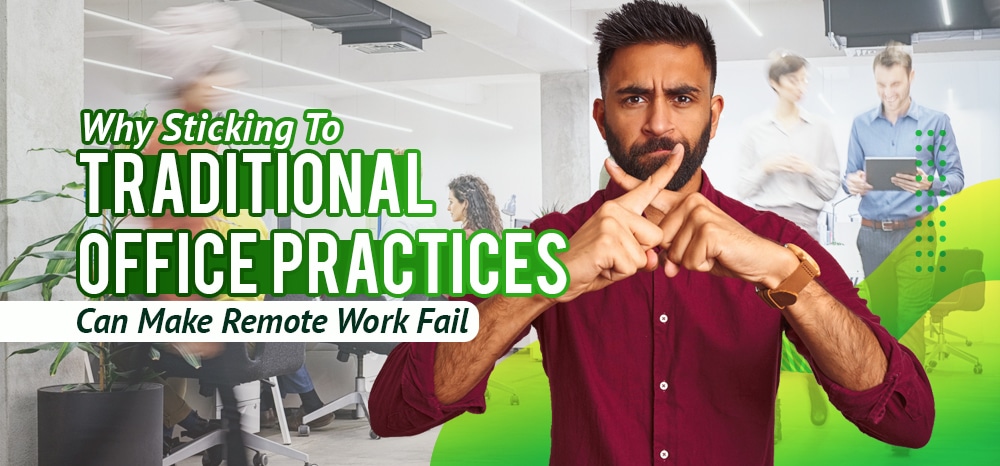It’s been two years since the world embraced working remotely. And thanks to that, many companies have managed to survive and even bounce back. Online shops and e-commerce platforms are fast becoming the norm too, leveling the playing field for many SME’s.
But many companies are still averse to embracing or even sticking to a remote work set-up. Some complain about Zoom fatigue, increasing blurry work-life boundaries, or even what they perceive as reduced productivity.
However, the problem isn’t with remote working per se. Rather, it’s our unwitting attachment to office-based practices that today’s landscape renders obsolete.
Let’s take a look:
Our Concept of Seniority

The traditional work setup as we know it started decades ago. Hence, it’s unsurprising that a lot of old practices are largely irrelevant now. Trying to implement them in a remote work set up would be like forcing a square peg into a round hole.
For example, mentors have long been viewed as someone older and with more experience. The same goes for managers and supervisors. We’re simply used to correlating age with wisdom. Thus, it used to be near impossible for a talented employee to earn a promotion at a young age.
But today, innovative practices like reverse mentoring are turning this on its head. With digital natives entering the workplace for the first time, it’s only inevitable that older employees actually have a lot to learn from them now.
“When” to Work

One of the best things about remote work is its flexibility. In companies that allow it, employees can work at their own time and pace – as long as they produce quality output. This is quite the opposite of the traditional 9-5 schedule, which Henry Ford developed in 1926 for his factory workers.
It’s been almost a century since and let’s face it, this schedule doesn’t really make sense for most workplaces.
Think about it. What would you rather have? Employees who clock in and clock out the usual eight hours but spend most of their time looking busy? Or brilliant workers who maintain a reasonably flexible schedule and pump out A+ work in half the time?
It’s about time we stopped equating busyness with productivity.
“Where” to Work

For businesses and organisations, a brick and mortar address used to indicate legitimacy. Many employees also used location as a factor when planning their careers as a result.
But for today’s workers, they won’t need walls anywhere to define where they work.
With more and more employees leaving their old jobs for ones that offer remote working options, the demand for office space is steadily declining. And this brings with it undeniable advantages.
One is cost. The lack of office space means you won’t need to shell out for a lease and for the accompanying utility expenses.
Another is your reach. If you can adapt so that a distributed team can handle your company’s operations from practically anywhere, you can hire the best talent around. No need to limit yourself to the ones in your town, city, or even in your country.
“How” to Work

Employers who have yet to hire remote workers worry about how they could possibly monitor their productivity. That’s understandable. For decades, our concept of such intertwined showing up to the office and spending eight to 10 hours sitting at our desks, regardless of whether anyone accomplished anything significant or not.
But that should no longer be the case. We should start taking results at face value, rather than nitpicking how long someone took to produce them.
Remote work has also redefined what it means to collaborate. Zoom meetings are fine, but with
24 percent of employees feeling emotionally drained after back-to-back sessions, schedule them sparingly. Especially if what you need to discuss could be summarised in an email.
Lastly, project management apps have also lessened the need for micromanaging. Once the entire team is proficient in using your app of choice, it gets a lot easier to coordinate workflows without constantly looking over people’s shoulders.
To sum it up, remote work works.
And when it doesn’t, that’s usually because companies tend to go into a remote work set-up with traditional office-based practices and expectations.
Fortunately, Remote Staff has partnered with Australian SMEs and entrepreneurs to find and hire skilled experienced Filipino remote workers for the last 15 years (and counting). More importantly, we also provide continuous support and assistance to make remote work work for you.
Call us today or schedule a call back so we can get started.
Serena has been working remotely and writing content for the better part of the last decade. To date, she's written for Pepper.ph and Mabuhay Magazine, among others, and has churned out more than a thousand articles on everything from The Basics of Stock Market Investing to How to Make Milk Tea-Flavored Taho at home. Hermits, aspiring hermits, and non-hermits with interesting project propositions may email her at serena.estrella10@gmail.com.
























 Zero Recruitment Fee
Zero Recruitment Fee